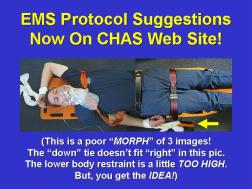

 |
A Reader's Letter |

Received February 6, 2002
Dear Ms. Miller:
As a >20-year medic, I am nevertheless relatively new to these ideas and problems occasioned by "hog-tying." However, on those fairly rare occasions where physical restraint was required, I, too, have preferred (and requested) re-restraint in a supine position.
One problem: now that we have prevented positional asphyxia by freeing his respiratory muscles, we must be in position to prevent asphyxia secondary to aspiration. Suction will (if immediately available) perhaps limit the mess but, I suspect, do less to prevent the next-breath inhalation of vomitus.
In order to prepare for both situations, perhaps the supine restraint technique ought to incorporate the use of a long spine board. I believe most traditional devices would accommodate exactly the same tying technique described in your description of the supine restraint technique.
I have learned something today, and appreciate the chance to contact you.
J T Stevens, NREMT-P
Douglasville, GA

FROM CHAS: BLESS YOU, JT!!!
Dealing with emesis produced by a supinely-restrained patient, who is not spine-injured, has always been easy - messy, but easy: Turn their head! Yet, in the past year, as I've worked on several wrongful-death Restraint Asphyxia cases, I've come to recognize the following fact:
Since almost ALL individuals requiring full-body-restraint incur SOME "trauma" before or during the incredible struggle they enact, almost ALL individuals requiring full-body-restraint should ALSO be "SPINALLY IMMOBILIZED!"In fact, in several of the cases I've worked on, the individual HAD trauma prior to restraint. But, the responders developed "tunnel vision," and only were concerned with "restraining" the individual. Thus, if the responders had followed trauma protocols, and the individual had been "spinally immobilized," he would NOT have died of Restraint Asphyxia! Why? Because he would have been restrained SUPINE, on a long back board (LBB).
What JT proposes is incredibly smart. If someone is supinely-restrained to a LBB and begins to vomit (and suction is not handy), the board can be "tipped" to the side, just as for any "spinally-immobilized patient." Still messy! But, certainly in the best interest of our patient.
Another benefit of LBB restraint: Those of you with those "heavy-duty" pram/cot/gurneys - such as Stryker's "Rugged"(tm) or Ferno's "35-A+ Mobile Transporter"(tm) - NOW have a safe and effective means of providing "Medical Restraint!"
The "heavy-duty" pram/cot/gurneys are notorious for being designed in a manner that provides little-to-NO room for adjustment of restraint-belt attachment, both above and below the patient's waist. If their placement cannot be easily adjusted, their use as safe and effective restraints becomes compromised. Compromised restraints are always poor restraints - often even injurious restraints!
Perhaps even BETTER than the above reasons to use LBB restraint, though: Think of how much EASIER (and SAFER) it will be to transfer them to the emergency department's bed! Remove the pram/cot/gurney "safety belts," and the patient remains supinely-restrained to a LBB. Then, you just lift them over to the ED's bed!
all my restraint articles and educational programs to include this practice.
(The Slide pictured at right already reflects
In the mean time, Plz help me Spread The Word! |
 |
Thanx, again, JT!
CHAS


 Email Charly at: c-d-miller@neb.rr.com
Email Charly at: c-d-miller@neb.rr.com